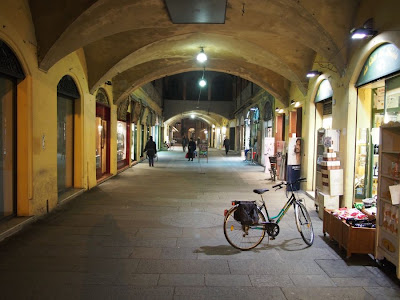After using the
Parasonic Lumix GF3 that I bought second hand just before Christmas, I began to
wonder if it was really still necessary to carry all that heavy DSLR gear up and down the Apennines mountains to
achieve decent image quality. The GF3 output is not up to the Nikon D300 that I use at
present.
Whilst buying a
cheap second hand telephoto for the GF3,
curiosity got the better of me and I tried out the newish Olympus OM D
E-M5 with a 16MP sensor. I also saw some photo’s taken with this camera. I was instantly sold on this fantastic little camera.
 |
| Olympus OM D E-M5 and Lumix G X Vario 12-35mm f/2.8 ASPH |
So all my 6x6 medium
format and 35mm manual focus stuff that had been sitting unused was traded in
for the Olympus and seeing that I hate slow lenses I also bought the top of the
range Lumix 12 -63 2.8 zoom.
Next job was to
try to see how this cutting edge Micro
4/3 equipment performs. Some free time and a nice sunny day coincided, so I went
up to Canossa and Rosenna (RE) to get to grips with all this new gear.
Here are some
pictures.
 |
| Castello di Canossa, RE |
 |
| Castello di Canossa, RE |
 |
| Castello di Canossa, RE |
 |
| Castello di Canossa, RE |
 |
| Castello di Canossa, RE |
 |
| Castello di Canossa, RE |
 |
| Castello di Canossa, RE |
 |
| Castello di Canossa, RE |
 |
| Castello di Canossa, RE |
 |
| Castello di Canossa, RE |
 |
| Canossa, RE |
 |
| Canossa, RE |
 |
| Castello di Rossena, RE |
 |
| Castello di Rossena, RE |
 |
| Castello di Rossena, RE |
 |
| Castello di Rossena, RE |
This Micro 4/3
stuff is really good for night time photography.
So how good is this
stuff ? The sharpness and tonal range are a bit better than the D300. The fact
that Lumix lenses are not corrected in camera for chromatic aberrations when shot
on Olympus cameras means that for some
shots (branches against snow) it was necessary
to correct for CA’s and I think some sensor bloom in the raw
converter. Nikon do a good job automatically correcting CA in their lenses by software. Also I love the
image stabilizer, which is good with telephoto lenses, eliminating the need for
a monopod. The best thing
of all is that this kit weighs a fraction of a D300 camera with a couple of
lenses, which is important when I go walking in the mountains.







































